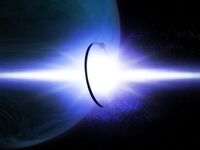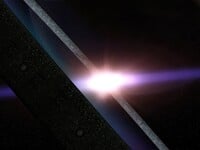Halo Array
From Halopedia, the Halo wiki
“Installations” redirects here. For other uses, see Installation (disambiguation).
Template:Article Quote
The Halos[1] (as they are commonly referred to based on intercepted Covenant transmissions[2]), alternatively known as the Sacred Rings[3] by the Covenant, Fortress Worlds[4] by their creators, and Installations by the AI Monitors that run them, are seven massive ring-shaped installations constructed by the Forerunner throughout the galaxy over one hundred thousand years ago as a last resort when combating the parasite known as the Flood. When nothing else could be done, they activated the rings which killed all sentient life within three radii of the galactic center. The Halos are also research facilities, as well as weapons of last resort.
Background
Each installation was constructed orbiting a giant gas planet, and although the reason for doing this remains unknown, it has been speculated that the planet was used as a base for the Forerunners while constructing the rings. An alternate reason could be that the Flood cannot occupy or pull resources to construct a ship from a gas planet or it was the Ark that built the Halos because in Halo 3 the Ark is preparing a new Installation 04. Another theory is that the gas giants would magnify the ring's blast radius when fired. The seven Halos are designed to be remotely controlled from a facility called "The Ark"[5]. In addition to the Halo installations (Installations 01-07) and The Ark (Installation 00), the Forerunners also built Shield Installations [6] to rescue the inhabitants from the destructive power of the Halos.
Each Halo has a simple designation, consisting of "Installation 01-07 respectively".
Features
Custodial
The installations are designed to be run by advanced Artificial Intelligence constructs specially purposed by the Forerunner. The highest Intelligence on each Installation is a single Monitor[7]. The Monitor's task is to ensure that the Installation runs smoothly, that the Flood stays imprisoned, and that the Installation is ready to fire on demand. They also simulate activation of the Halos regularly. At least one of the Halos has a successful firing record of 1.2 trillion simulated firings, and all seven of the Halos have been fired at least once before as part of the initial purge[8].
In addition, each Installation contains less intelligent constructs, the Sentinels. The Sentinels serve virtually any purpose necessary to ensure that the Halo works properly; they are also capable of combating small Flood outbreaks. Should a major Flood outbreak occur, heavier automations, such as the Enforcers and Sentinel Majors will be created to assist the Sentinels. In the meantime, Constructors are also created to ensure that the Forerunner structures on the Installation are kept in optimal shape, and that they are not damaged by conflict or weather[9].
Save for the Monitor, all automations can be constructed at specialized Sentinel Production Facilities that float high in the Halo's atmosphere. These Facilities have never been seen (except briefly in the sky above the level Sacred Icon, one can be seen crashing as you exit near the end of the level, you then fight through the remains of it in Quarantine Zone), but they seem to contain limitless materials for constructing any number of automations.
Environment
Each Halo was designed with extraordinarily complex environmental systems and ecosystems. Though each Installation is built similarly, most of their environments appear to differ radically. Installation 01's environment appears to be a desert; primarily dry and arid with little water. Installation 02's atmosphere is apparently arctic, as the installation is completely frozen over with ice. Installation 03 is a lava world, the entire ring is covered in magma and fire. Installation 04's environment corresponds most closely to a temperate forest, with many coniferous trees and evergreen forests covering its surface. Installation 05 is a jungle world with many forms of life and a hot, wet atmosphere. Installation 06's atmosphere is difficult to discern based on readouts alone, it appears to be covered in either water or blue rock. Installation 07 is rocky and barren, with many mountain chains and rocky craters[10].
However, the two Installations visited (04 and 05) had radically different extremes within the installation, and each installation likely has many kinds of climates on their surfaces, ranging from arctic to temperate to desert.
The terrain may appear to look naturally formed at first glance, but it was revealed at the end of Halo 3 that the environment is intricately terraformed by a network of panels several meters below the natural surface that appear to control variables such as hills and slopes. Other seemingly natural features, such as rock arches, are intentionally placed and are supported by artificial frameworks below the surface. However these functional aspects of the Halos' environments are only visible under a few circumstances, including when the ring has not yet been completely terraformed during construction. Parts of it that have been constructed can be seen on the last level of Halo 3, "Halo".
Technology
Each Halo has a Control Room located in a temple somewhere on the ring. The Control room serves as the central chamber for the Ring's activation, and serves to control all functions of the ring. It is the Installation's command center.
Each Installation contains a number of basic Structures, including a "Library" which contains an "Index." The Index is the key to the Installation's activation[11]. They also contain a "Silent Cartographer" which serves as a map to the Installation's Control Room.[12], as well as numerous Flood Containment Facilities and Flood Research Facilities. Every Halo has live Flood specimens that are kept for study. Any Flood outbreak is caused when these specimens somehow escape containment.[13]
The Installations also contain advanced transportation grids for use by the Monitor. These Grids allow instantaneous transportation to any place on the ring for the Monitor and any other persons or things it chooses[14]. The Installations are also riddled with travel conduits, presumably for the Monitor and Sentinel to move around quickly.[15]
Function

The Halo system is complex, but the Halo's main weapons can be activated individually from within itself, or all of them simultaneously from a control center known as The Ark. In the event of a major Flood crisis, the Installation's Monitor will seek out a "Reclaimer" who they will immediately transport to the Library. They must navigate to the Index Chamber, and then retrieve the Index. The Monitor then stores the Index for safe keeping, and they immediately proceed to the Control Center. Once at the Control Center, the Reclaimer must insert the Index into The Core of the Installation (protocol does not allow the Monitor to activate the ring itself - it can only be activated by a Reclaimer). Once this happens, the main weapon fires. The main weapon is then amplified by the Phase Pulse Generators built into the ring, and the weapon expands in an unknown form of energy (possibly a gamma ray burst, though this would not explain why it only seems to kill sentient life or life with sufficient biomass to sustain the Flood). The particular form of energy of at least one Halo (Installation 04) has an effective radius of approximately 25,000 light years (147,000,000,000,000,000 miles/147 quadrillion miles). The activation also triggers the other six installations, and their systematic activations cause a chain reaction which affects the entire galaxy, eradicating all forms of sentient life with enough biomass to sustain the Flood[16]. However, the exact method of this process is still unknown. In Halo: Ghosts of Onyx, a warning is received from Cortana stating "...Highest possible threat assessment from biological contamination and radiological annihilation from Halo detonation." This seems to suggest that Halo's main weapon is radiation-based. Yet this is contradictory, because enough radiation would destroy the Halos themselves and render the array useless. The debate goes on. One method the Halos could function could be using Slipspace to spread the gamma ray bursts to overcome the speed of light dilemma. The ring could create Slipspace events like ripples on a pond, in effect creating multiple concentric sources (say the distance between two are 100 light years) of gamma ray bursts situated around the ring. This way, the bursts could cover a larger area faster, although each succesive source would be weaker than the previous.
History
The Halos were created a few hundred years after the Flood was discovered by the Forerunners, because their builders saw that their current isolation and containment procedures were not adequate to stop the spread of the Flood. Little is known of their extensive history, (At least one was functional for 101,217 Local years)[17] but after exhausting every other tactical option, their creators had no choice but to activate the Halos' main weapon, and destroy all sentient life in the galaxy[18]. It is possible, and implied, that the Halo rings were not used in conjunction with the Key of Osanalan, causing the Halos failure to completely obliterate the Flood. This may also mean that the Halos were fired prematurely, and may possibly have killed the Forerunners, thus explaining their mysterious absence.
The seven halos then remained relatively dormant for one hundred thousand years (Though at least one of them experienced a major Flood outbreak; and reference given to brief visits by other species by 343 Guilty Spark) until one of them, Installation 04 (known amongst fans as Alpha Halo), was discovered by the theocratic alien superpower, the Covenant. The Covenant, who revered the Forerunner as gods, believed that the Halo's main weapon was actually a "divine wind" meant to propel them on a path they called the "Great Journey". During their investigations on Installation 04, the Covenant encountered the Flood, however they quickly contained the outbreak. After the arrival of the Human vessel UNSC Pillar of Autumn, Captain Jacob Keyes accidentally breaks the containment, thinking to find a large Covenant weapons cache. A massive four way melee ensued between the Covenant, the 343 Guilty Spark-led Sentinels, the Flood, and the Humans. This finally culminated when the Human Supersoldier known as the Master Chief detonated the fusion engines of the Pillar of Autumn on the surface of the Installation, completely destroying a section of the ring, and, due to the gravitational momentum and inertia still perpetuating the ring in orbit around Threshold, tore the ring apart into pieces. The remains of installation 04 are scattered as debris in space, both large and small. The explosion sent massive chunks of the ring careening into the moon Basis, as seen in the Halo 2 Multi-Player Level "Burial Mounds," due to the constant bombardment of small objects from the ring as seen in the sky on that map. Other large sections of the ring are seen in the opening scene of Halo 2, drifting in space around Threshold. It is also highly likely that large portions of Alpha Halo debris were drawn into Threshold, never to be seen again. [19].
Later, a second Halo, Installation 05 (known amongst fans as Delta Halo), was discovered. On this Halo, the Flood had already been released somehow. And owing to this, a similar conflict erupted. This conflict ended in the flood manifesting a Gravemind and successfully escaping the ring aboard infected Covenant ships. The ring was nearly activated by Tartarus, a Brute Chieftain, but Commander Miranda Keyes pulled the Index out of the Installation at the last moment, causing the six remaining Installations to go on "standby mode", ready for remote activation from the Ark.
The Humans return to Earth and resume their fight against the Covenant, who have uncovered a large structure on Earth, which they assume to be the Ark. The Covenant set the Forerunner Dreadnought down in the center of the structure, activating it. To everyone's surprise, the structure is not the Ark, but a portal to the Ark, a massive artificial world located outside the galaxy. Human and Elite forces go to the Ark to try and stop the Covenant from activating the Ark, thus activating the remaining Halo rings. It is then that the Flood Gravemind appears, having turned the Covenant planetoid city High Charity into a Flood hive. The Hive crashes on the Ark, releasing the Flood.
It is revealed at this point that the Ark was constructing a new Installation 04, to replace the one destroyed, that is only days from being complete. The Humans eventually decide to activate the new ring to stop the Flood, which in turn destroys itself and damages the Ark. It is unclear how the system was affected by this, but the Halo system appears to have been irreparably damaged by the destruction of Installation 04, it's monitor(343 Guilty Spark), and the Ark.
Astronomy
The "Ringworld" of Halo is much smaller than Larry Niven's Ringworld. While the diameter of Niven's ring world is close to the diameter of Earth's orbital of 300,000,000 km, the 10,000 km diameter of Halo is much closer to the diameter of Earth itself, which is 12,756 km. Ringworld has a star similar to our sun in its center, and Halo is orbiting a planet, but does not encircle it.
Besides the very beautifully sculpted landscape on Halos surface, the sky is also worthy of attention. Depending on the viewpoint, you can see a star, a moon (called Basis), a gas giant (called Threshold), and the band of Halo itself, which looks like a street into the sky.
In the course of Halo: Combat Evolved, neither Threshold nor Basis is reachable, all action takes place on, in, or near the Halo. In Halo 2 there is a multiplayer level on Basis, and there is a campaign level on a gas mining facility in Threshold's atmosphere.
While the locations of the other Halo rings are unknown, it has been speculated that Alpha Halo was located in the Iota Horologii System.
Trivia
- On the Halo PC menu, look closely at the Halo before it starts moving. Somewhere on it you can see the letters Gny Sgt Marcus, referring to Marcus R. Lehto.
- The Halo textures for both Halo 1 and 2 are the same, and are both symmetrical. Thus, when you look straight up, a shape in the clouds of the Halo resembles a Grey alien. It could have been put in there on purpose, although it might be a coincidence.
- Halo: Ghosts of Onyx describes the Halos as being the "sword" of the Forerunner, as the Shield World was their "Shield." This description is mysteriously similar to the lines Cortana says on the Halo 3 Announcement Trailer; "I am your shield, I am your sword."
- In the clouds of Halo, on every level, you can see the face of Chris Carney. This can also be seen in Halo 2.
- Considering its 10,000 km diameter, Halo would need to rotate at 7 km/s in order to produce Earth-like "gravity". However, in the novel "The Fall of Reach", Cortana says that "some numbers don't check out" and discovers an artificial gravity field on the ring.
- In Halo Combat Evolved Prototype, Installation 04 had a disconnected section where there is a railroad bridge that floats in space.
Sources
- ^ Halo: Combat Evolved, level Truth and Reconciliation
- ^ Halo: The Flood page 38
- ^ Halo 2, level Gravemind
- ^ Halo: The Flood page 193
- ^ Halo 2, level The Great Journey
- ^ Halo 3, level The Ark; Guilty Spark~: "I always thought that The Ark was part of a shield installation"
- ^ Halo: Combat Evolved, level 343 Guilty Spark
- ^ Halo 2, level Gravemind
- ^ Halo 2, level Sacred Icon
- ^ Halo 3, level The Ark (Level)
- ^ Halo 2, level Regret
- ^ Halo: Combat Evolved, level The Silent Cartographer
- ^ Halo: The Flood page 240
- ^ Halo: Combat Evolved, level Two Betrayals
- ^ Halo: The Flood page 242
- ^ Halo: Combat Evolved, level Two Betrayals
- ^ Halo: The Flood page 238
- ^ Halo 2, level The Great Journey
- ^ Halo: Combat Evolved, level The Maw


